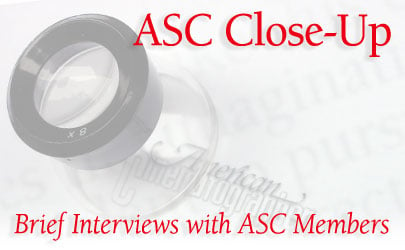 |
||||
 |
|
|||
| Don McCuaig, ASC |
|
|||
When you were a child, what film made the strongest impression on you? The Robe, photographed by Leon Shamroy, ASC, the first Cinema-Scope film produced by 20th Century Fox. When Fox studio head Darryl Zanuck finished his introduction and the screen opened up to exhibit the film in 2.35:1, I was astonished. I believe CinemaScope created a new paradigm in the motion-picture industry. To see that film as a young boy and now have opportunities to photograph in 2.35:1 widescreen is a source of great pride for me. Which cinematographers, past or present, do you most admire? That’s a very tough question. The following ASC members have influenced my work and/or given me opportunities: Russell Boyd, Conrad Hall, Jordan Cronenweth, Dean Semler and Philip Lathrop. What sparked your interest in photography? I was trained as an instrument/optical technician, and once I entered the entertainment industry, I felt a great pull to the visual side of the process. I was instantly hungry to learn the craft and artistic elements of both photochemical and electronic cinematography. Who were your early teachers or mentors? In the Seventies, an opportunity to work with Philip Lathrop as a second AC changed the way I looked at and approached cinematography. Observing him taught me more about the process than anything or anyone in my career; he gave me the keys to unlock the magic of the craft. Also, Vilmos Zsigmond, ASC influenced me as the master at several cinematography workshops. He was very generous with his time as well as his deep knowledge of filmmaking. There are others too numerous to mention. What are some of your key artistic influences? I have always loved the outdoors, and in particular landscapes. An artist I love is Sydney Laurence, painter of the north; his work is breathtaking, and to re-create it on film or as a still would be fantastic. Because I’m a product of the 1940s, television was not on my radar, so motion pictures played a huge part in the way I perceived the world around me as well as the world in the distance. Their influence impacts my work and life to this day. The classical portraits I’ve had the great pleasure of seeing during my journey have also affected how I see the world, and taught me how we can create pleasing visuals that help tell the story at hand with the right lighting conditions and locations. How did you get your first break in the business? My first break came at NBC Television in Burbank on Stage 4, where I pushed scenery for the Andy Williams and Dean Martin variety shows. I’ve not been out of work since, and I’ve had chances to direct, produce, own a production company, and do what I love most, cinematography. What has been your most satisfying moment on a project? The 1976 Summer Olympics in Montreal. The chance to photograph the finest athletes of that era has always been a fond memory. It closed one chapter in my career and opened another in narrative filmmaking. Have you made any memorable blunders? I’ve made more than I can mention, big and small. Have they hurt me? Without a doubt, but it is much like being in a fight for your life and your career. You learn from them and don’t make the same ones again. I believe reflecting on missteps makes you stronger, better, and ultimately a winner in life. What’s the best professional advice you’ve ever received? While shooting newsreel for the Canadian Broadcast Corporation, producer Allan Clapp told me I should analyze every frame of film or videotape I shot. It has been a tremendous help. Also, Woody Omens, ASC told us at a Panavision workshop that it was important to examine laserdiscs, freeze a perfect frame, and dissect the lighting. What a great gift. Other important advice was three words: ‘Prep, prep, prep.’ Do you have any favorite genres, or genres you would like to try? I am a great fan of historical epics. An epic is a challenge I’d like to tackle before I hang up my meters. Anything is possible in Hollywood if you don’t give up. If you weren’t a cinematographer, what might you do instead? Maybe an archaeologist. But at this point in my life, it’s hard to imagine doing anything else. This is not an easy business by any stretch of the imagination — you have no family life, long hours, difficult locations, and occasionally collaborators who are not all that reputable or easy to deal with. But I love what I do. Which ASC cinematographers recommended you for membership? Brad Six, Kenneth Zunder, Lowell Peterson and Robert Caramico. My biggest advocates were Roy Wagner and Francis Kenny, without whose dedication and hard work I would not be a member today. How has ASC membership impacted your life and career? ASC membership is a great honor. To be at the Clubhouse and rub shoulders with the finest cinematographers of the modern age is one of the highlights of my life and career. I’ve always been a student, and the ASC has been one of the great resources for continuing my education. The members love to share their knowledge and resources through workshops, seminars, meetings and community outreach. |
|
|||
|
<< prev |
||||
|
|
|
|
|
|


